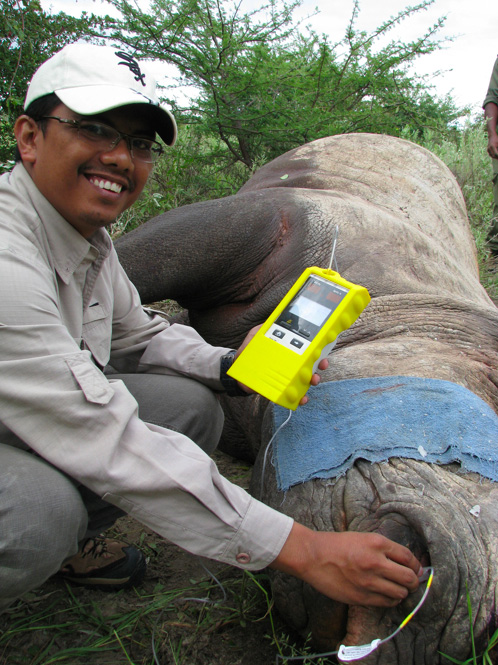Africa Blog
 Dr. Dedi with an African black rhinoceros in faraway Namibia. The black rhinoceros (Diceros bicornis) measures two to three times larger than the smaller rainforest rhinos he cares for back home in Sumatra, but Dedi nevertheless learned a lot from this unique training experience. Thanks to Living Fossil Foundation and Oridion Capnography for making this partnership possible.
Dr. Dedi with an African black rhinoceros in faraway Namibia. The black rhinoceros (Diceros bicornis) measures two to three times larger than the smaller rainforest rhinos he cares for back home in Sumatra, but Dedi nevertheless learned a lot from this unique training experience. Thanks to Living Fossil Foundation and Oridion Capnography for making this partnership possible.
What I Learned Working With Namibia's Black Rhino Capture Team?
The opportunity to join the capture team in Namibia was extremely rare and exciting. I must give my sincere thanks to the Namibian Ministry of Environment and Tourism and particularly, Dr. Mark Jago and Pierre DuPreez, who facilitated my visit. This adventure proved to be a very valuable learning experience for me personally and certainly for rhino conservation in Indonesia because I dedicate my life and experiences in order to save critically endangered species of Indonesian Rhino.
During my three-week working trip with Dr. Radcliffe and his team from Cornell University, my personal goal was to learn as much as possible about the capture of free-ranging rhinoceros in the wild using the African technique together with the use of new tools to monitor biological functions of the rhino. This experience will be very useful and have far-reaching benefits to help improve our knowledge. I hope this activity will enhance my ability in making important decisions in the handling of the Sumatran rhinoceros especially in the field where I work now to maintain the Sumatran rhinoceros in the Sumatran Rhino Sanctuary. The country of Indonesia will benefit indirectly by knowing that their endangered rhinoceros are being saved for future generations.
This experience will be useful to one day adapt to our conservation efforts in Indonesia, even though our situation is quite different from Africa. A few years ago we experienced a displaced rhino in Way Kambas National Park. A wild rhino (later named “Ratu”) left Way Kambas and proved very difficult to drive back to the forest. We were lucky that the rhino survived our manual capture method without anesthesia (the rhino was not darted or otherwise sedated in any way). Following the manual capture, the rhino was diagnosed with myopathy. Knowledge about rhino capture is important to translocate displaced Sumatran rhino using safe procedures to help save these rare forest animals.
I consider myself very lucky to have met and worked with so many rhinoceros experts during the course of this study. I now have new contacts with rhino capture vets, rangers, ecologists and pilots that can help advise future projects in Indonesia. The Namibia Rhino Team has generously offered their considerable knowledge if we should one day need to safely capture and relocate the Javan or Sumatran Rhino.

Doctor Dedi Joins Namibia Capture Team